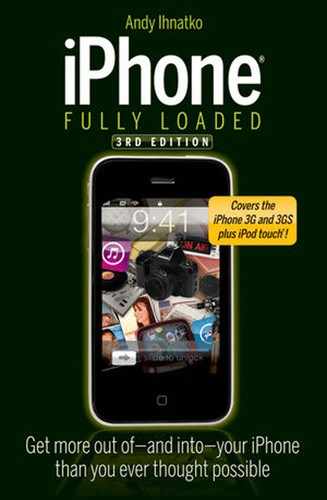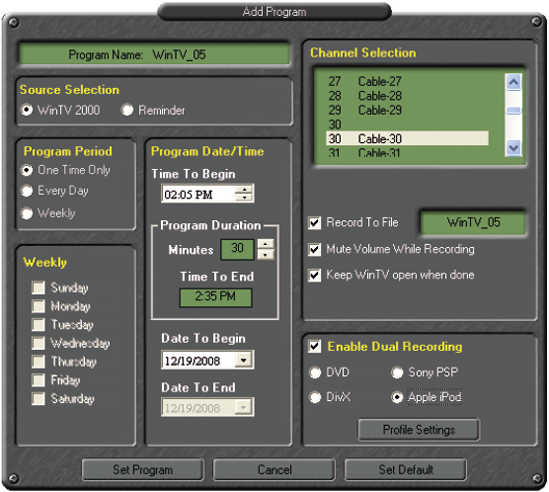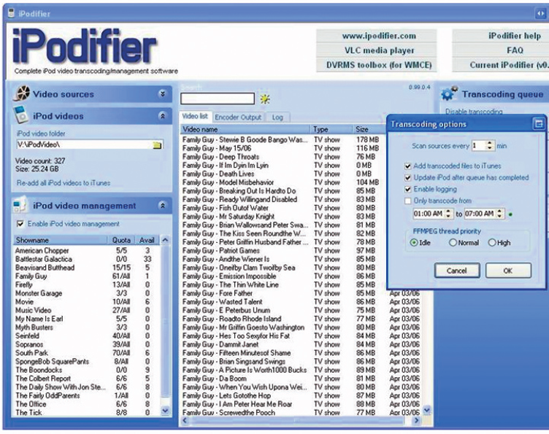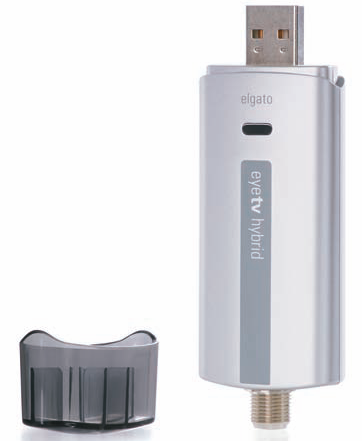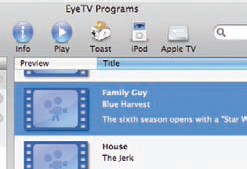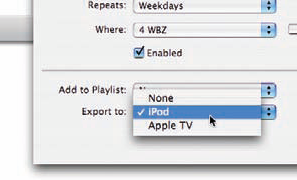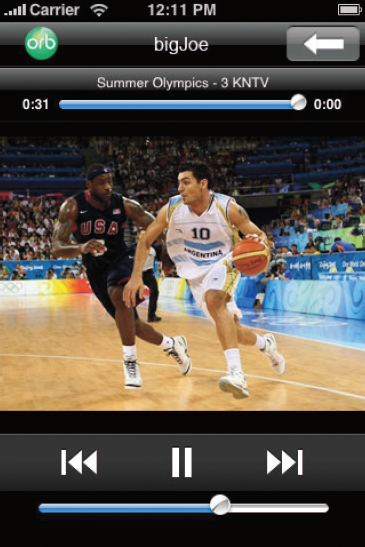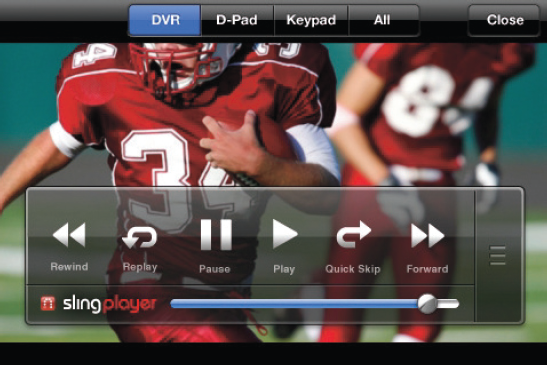TV to PC to iPhone
I like the iTunes Store, I use the iTunes Store, and I want to support the iTunes Store. Those plucky Apple kids are showing a lot of spunk with their little garage startup, and if this is what they want to do after college instead of going on to law school like they've always said they wanted to, well, it breaks our hearts — mine and their poor mothers' — but we always said that we wanted to raise kids with enough confidence and self-reliance to choose their own paths in life.
But all too often, folks count on the iTunes Store as their sole means of acquiring content. It's like fast food. It's quick and it's easy and it's always available. But it's always more money than you need to spend, and it only offers a limited menu.
I'm pretty surprised, for instance, that folks pay $30 to $50 for season passes to their favorite shows. If you're willing to be a season behind at all times, that's more than the cost of that same season on DVD. And you don't get a DVD's higher video quality or its huge quantity of extras.
And if you don't want to wait, then hell, you can buy simple TV tuner hardware that plugs into a USB port. A USB TV tuner is afford-able. It's a tiny and simple piece of hardware, usually no larger than a USB thumb drive.
Whether over-the-air (ATSC) or clear-QAM cable programming, it records pure digital signals that are every bit as good as anything you'd get from the iTunes Store — and the shows you record can be added to your iTunes library and synced to your iPhone automatically, shortly after the show's end-credits have been squished off the side of the screen.
If you were going to buy two or three season passes, you've more than covered the cost of the hardware. And remember, Late Show with David Letterman isn't coming to the iTunes Store anytime soon.
So it's a choice of either the infinite possibilities of cooking your own TV content or spending more money and having a limited range of options. It's a no-brainer.
On the Mac, there's really only one choice for TV-recording hardware and software. But on a PC, there's ... let's see ...
(Ihnatko shoves the edge of his desk and sends self and his chair to the other side of the office; retrieves a big plastic tub full of hardware; crab-walks chair back to desk.)
... at least seven. But my favorite continues to be the broad line of choices available from Hauppage (www.hauppage.com).
You can buy a dirtcheap, $55 card that installs inside your desktop PC, a little $80 USB box, a just-as-cheap thing the size of a USB thumb drive that you can easily take with you when you travel ... even big $200 cards that can record digital satellite TV and features dual tuners so that it can record more than one show at a time.
They all include Hauppage's WinTV tuner/PVR (personal video recorder) software, which is a treat to use. WinTV is available in both conventional analog and bleeding-edge digital TV editions.
Unfortunately, the WinTV software doesn't support iTunes directly. But the company offers Wing, a $25 add-on app that can record TV shows directly to your iPhone or iPod Touch by simply clicking a checkbox (see Figure 7-1).
I can tell just by the way you're holding this book that you're a person of wealth and taste. It's possible that you already own a machine that records TV shows digitally.
If you happen to use the Media Center features available in Windows Vista or Windows 7, there's a fab little app that can take its programming, convert them to MP4 files, and add them to your iTunes library: iPodifier, a free download from www.ipodifier.com.
Figure 7-2 shows the app in action. After a few moments of pointing and clicking, the shows you've recorded will be transcoded into an iPhone-studly format and squirted into your iTunes library.
In the grand tradition that's been kept alive by everyone who's ever gotten a tattoo on an impulse, I'm going to pretend that something bad is actually exactly the perfect thing. Watch me:
"Hey, isn't it terrific that there's pretty much only one solution for recording TV on a Mac? Those poor bastards with PCs have to make a decision after looking at almost a dozen different options!"
Okay, well, it's not like there's really only one piece of tuner hardware and PVR software available. For the Mac there are as many as ... um ... okay, two.
But the only one I'll tell you about is the EyeTV from Elgato. The hardware and software are head-and-shoulders above anything else. They have a whole line of external boxes that work on nearly all Macs, including conventional and HDTV options.
Check out products and prices at www.elgato.com. I use the $149 EyeTV Hybrid, seen in Figure 7-3, for both my desktop and my MacBook. It's compact enough to travel with me and silently keep me up to date with the irresponsible self-absorbed recreational drug use of Dr. Gregory House while I travel.
As a Mac-only product, the EyeTV software is aggressive in its support for iPhones and iPods (see Figure 7-4). Any recorded show can be transcoded to the correct specs and added to your iTunes library with just one click.
As with almost any transcoding process, it'll take a while before the file's finished (even on an Intel-based Mac, it can take two times the running length of the show). But if you've set EyeTV to record your favorite shows, you can have the app convert the programs to iPod the moment recording is finished. Just choose the iPhone option from the Export To pop-up menu in either the show's schedule detail view (see Figure 7-5) or in the schedule list itself.
With the iPhone export option enabled, by the time you wake up in the morning all of the nights' recordings will be waiting for you in your library and ready to sync to your iPhone or your iPod Touch. Just don't watch them while you drive; it's very rude to the person you're talking to on the phone in your other hand.
Recording TV to a hard drive and then syncing it to your iPhone is lovely. But when you're being dragged to a cousin's daughter's dance recital on the evening of a possibly deciding World Series game, "record, then watch" technologies fail you.
There are in fact a couple of slick ways to stream live TV from your home to your iPhone. The slickest is Orb, a streaming service available only for Windows PCs. Go to www.orb.com, download the free app, and set up a free account. Then download the $9.99 OrbLive app from the iTunes store. The software, which you must leave running on your desktop, maintains a connection between your tuner and Orb's central server; the iPhone app connects to the server and offers a range of live features (see Figure 7-6).
And Elgato's EyeTV also has a brand-new, $4.99 iPhone app — so new, in fact, that I am hastily adding this paragraph to the book just a couple of days before the book goes to press — that will stream live or recorded TV from your Mac to your iPhone, provided that you have your EyeTV tuner plugged in and the software is running.
There are just two problems with Orb and EyeTV for iPhone. You do need to keep your PC or Mac up and running 24/7 (or at least during the whole evening you're going to be at the recital, hoping to see the Red Sox win their third Series), and you do need to have a computer.
The Slingbox, from Sling Media (www.slingmedia.com), is a far more ambitious, aggressive, useful, and expensive way to make your cable TV follow you wherever you go. It's actually a box that you interpose between your cable box and your TV. You plug it into your wired home network, stick an infrared transmitter in front of the cable box, and then you magically have the ability to "project" your cable box wherever you want it to go. Launch Slingbox's app on your PC or Mac and the software will automatically "find" your Slingbox no matter where you are in the world. Seconds later, you're watching whatever the cable box is pumping out, live as it happens.
Bonus: There's an onscreen remote control. Click the Next Channel button and the Slingbox sends the appropriate remote control signal to the cable box. You can change channels, search through your cable system's show guide, watch shows on your DVR, delete shows and schedule new recordings, ... It's exactly like sitting on your living room sofa, only way more complicated.
And there's an iPhone app, which you can peep out in Figure 7-7.
The bad news: It's a $29 app from the iTunes Store.
The worse news: It requires a Wi-Fi connection. You can't watch via the 3G cellular network.
I have sort of a genetic attraction toward the "record TV on a computer, have the computer transcode the show to an iPhone-compatible format" solution. When the computer handles everything from start to finish, you feel as secure and at peace as you do when you see the lady at Dunkin' Donuts box your half-dozen with a set of tongs.
But if you're going to go around buying hardware, you probably ought to consider the option of just buying yourself a stand-alone DVD recorder. It can make a timed recording the output of your cable box just like a VCR, and after you've burned the disc you can pop it into your PC or Mac and use any DVD-ripper software to convert the shows therein to video files. (Read all about that in Chapter 4.)
And because that DVD isn't copy-protected, you won't even need any of the extra decoding software that the PC apps usually require. It's more complicated than recording shows directly to your hard drive, but maybe you wanted to buy a DVD recorder anyway. It's up to you, all right? I'm just a man, here.
In a few weeks, I'll be taking a five-hour Amtrak ride from Boston to Baltimore. The night before I go it'll be very, very important that I check my EyeTV schedules and make sure that it's going to record and transcode about six hours' worth of overnight programming.
Which is in itself a double-edged thing. I was upfront with you about the nature of this book: If there's even 100K of unused space on your iPhone or iPod Touch, then you just aren't trying hard enough. But man alive, once you start using your desktop computer as a DVR, your goal stops being "I want to fill this 32-gigabyte device to full capacity" and starts being "Er ... you know, I now have less than 20 megabytes of storage on an internal hard drive that had about 200 gigs free last month, before I hooked up the TV tuner box."
Tip
The SlingPlayer app is one of those longstanding legends of iPhone app development. Sling wanted to sell this app. Desperately so. But Apple must approve all apps before they're placed in the store, and it was hopelessly stalled.
Rumors abounded that Apple was bowing to pressure from TV networks, or maybe AT&T (which didn't want its 3G network to get clobbered by thousands of people streaming bandwidth-hungry video). Maybe the Illuminati were involved.
As the months ticked by, and more people (like me) were personally shown a demo of the app and how well it worked and tongues continued to wag, the conspiracy theories became more baroque. It's probably significant that when it finally appeared in the App Store, it was limited to just Wi-Fi connections.
But there's a way around that limitation. Instead of getting your Internet connection from your carrier's 3G system, and instead of trying to locate a nearby Wi-Fi hot spot, get the best of both worlds with a MiFi. This gadget (made by Novatel) is available from Verizon and Sprint on a monthly subscription plan; it's a pocket-sized Wi-Fi base station that connects to the Internet via the carrier's 3G network. Press the button. After a few seconds, it appears to the iPhone (or any other Wi-Fi-enabled machine) as an Internet hot spot.
Presto, you can stream your Slingbox. It won't be anywhere near as fast as a conventional base station (remember, it's still just a connection to a 3G network) and your $60 a month only gets you a limited amount of data transmission before you start racking up overcharges. But it's a solution.
As I write this, the lack of free space has made my Mac slow and sluggish. I tell it, "You know what you should do? You should open Photoshop and help me edit these 320 photos I took at the MIT Flea Market last weekend." The computer takes a few moments to acknowledge me and even then, it clearly would just like to remain inert.
So in the end, a tv tuner box adds an extra level of sophistication to the homevideo experience. It's often been said that the purpose of DvR is to monitor hundreds of hours of tv programming so you don't have to. With the advent of a little USB peripheral, now your PC or Mac can duplicate the physical effects of so much tv watching as well.
